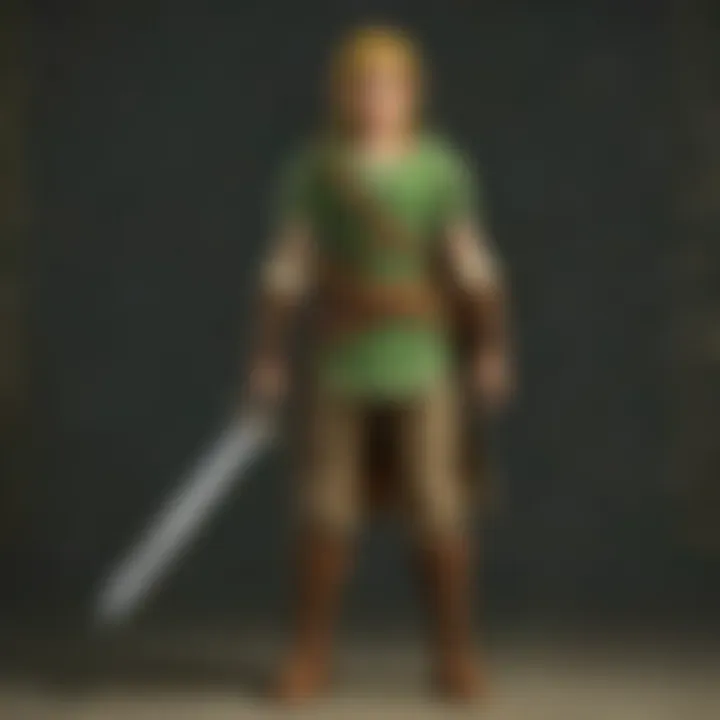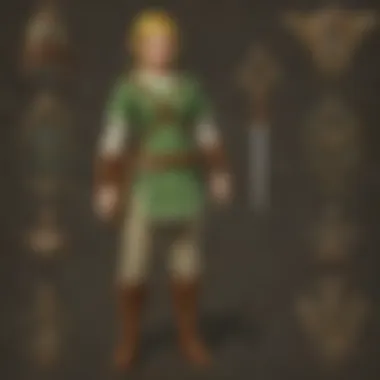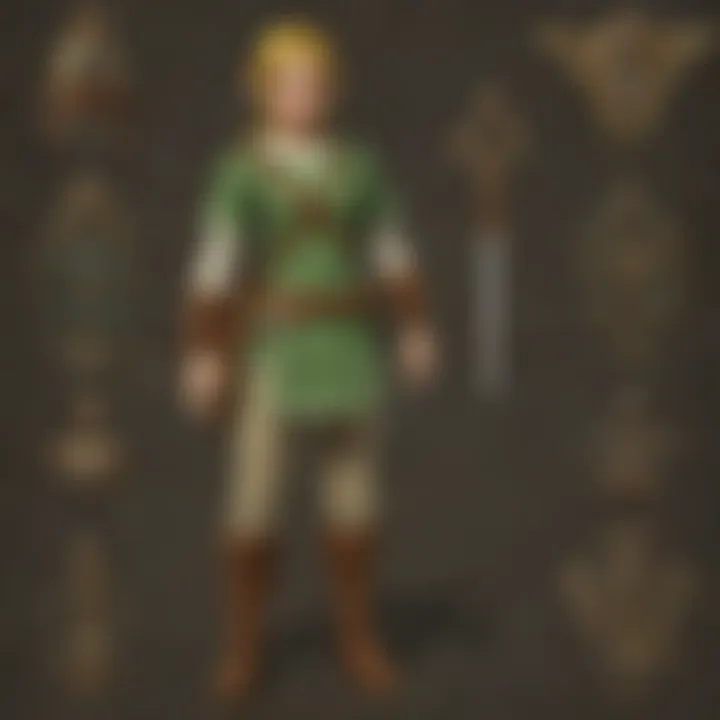Quest and Sidequest Dynamics in the Zelda Series


Intro
The examination of quest and sidequest dynamics within the Zelda series reveals layers of complexity and significance that often go unnoticed. This investigation highlights the unique design choices made by the developers and the ways in which they contribute to both gameplay and narrative structure. Quests are not mere tasks to complete; they are integral to the very fabric of the Zelda universe, influencing player engagement and the overarching story.
Zelda titles present quests that can vary in complexity and purpose. From primary missions that propel the narrative to sidequests that enrich the player's experience, every task contributes to world building and character development. Each quest serves as a vital thread in the tapestry that is the Zelda series, ensuring that players remain invested and immersed.
Game Reviews
Gameplay Features and Mechanics
The gameplay mechanics of the Zelda series are essential to understanding quest dynamics. Typically, players embark on a main quest that aligns with the narrative arc, often requiring exploration and combat with various enemies. Sidequests, however, introduce varied gameplay styles—puzzle-solving, collection tasks, and interactions with non-playable characters. Each of these mechanics maintains engagement and encourages players to explore the richness of the game world.
For instance, in Breath of the Wild, the open-world design allows for spontaneous encounters and multiple approaches to objective completion. Players can choose to follow the main storyline or deviate into numerous sidequests, making choices that reflect their play style. This flexibility enhances the sense of agency and personal investment in the game.
Storyline and Quests
The intertwining of storyline and quests shapes the player experience significantly. The central quests usually involve well-defined plots with tangible stakes, such as rescuing Princess Zelda or defeating Ganon. These arcs offer strong emotional beats and are often complemented by sidequests that flesh out the world and its inhabitants.
For example, the Majora's Mask sidequests, often tied to the tragic fates of various characters, deliver poignant stories that resonate deeply with players. The quests do not exist in isolation; rather, they enhance themes of time, loss, and redemption, ultimately enriching the narrative landscape of the game.
Visuals and Sound Design
Visual and auditory elements also play vital roles in quest engagement. The art style—ranging from the cell-shaded aesthetics of The Wind Waker to the more realistic approach seen in Breath of the Wild—creates a distinct atmosphere for each title. Coupled with dynamic soundscapes and iconic musical scores, these elements elevate the quests, making them memorable and impactful.
For instance, the haunting melodies associated with specific characters or events in Twilight Princess serve not only as cues but as emotional anchors. The sound design complements the visual storytelling, further enhancing the player's immersive experience.
Comparison with Previous Titles
The evolution of quest design across the Zelda series is notable. Early titles, such as The Legend of Zelda for the NES, focused on straightforward dungeon exploration and item acquisition. As the series progressed, particularly with titles like Ocarina of Time, complex narratives and multi-layered quests emerged.
Recent entries continue to innovate. Breath of the Wild represents a significant shift, favoring exploration and player agency over linear quest structures. Each iteration enhances the overall experience while maintaining core elements that have long defined the series.
"Quests in Zelda are not just tasks but a reflection of the player's journey through a beautifully crafted world."
Character Analyses
Popular Characters Overview
Characters in the Zelda series are more than just avatars. Heroes like Link and intricate figures like Zelda embody rich lore, each contributing to the quests in meaningful ways. Villains such as Ganon present obstacles that drive the narrative forward and define the quests.
Character Development and Backstories
Character development often unfolds through quests. As players engage with various characters, the depth of their backstories enhances the emotional stakes involved in completing quests. These personal connections drive the narrative and provide context for the greater conflict.
Role in the Zelda Universe
Each character serves specific roles within the universe that affect quest dynamics. They are not merely incidental; their motivations and actions directly impact the player’s journey. Understanding their roles can deepen a player's appreciation of the narrative.
Fan Theories and Speculations
The passionate fan base surrounding the series often speculates on character relationships and timelines. These theories can stem from quest narratives and lore, encouraging discussions about the interconnectedness of the Zelda universe.
Lore Discussions
Mythology and Worldbuilding
The quests contribute richly to the mythology and worldbuilding in the series. ]
Link's journey through different regions and historical encounters shapes a cohesive narrative, offering players a glimpse into a larger lore.
Legendary Items and Artifacts
Quests frequently lead players to discover legendary items, such as the Master Sword or the Triforce pieces. These artifacts serve not only as tools for gameplay but also as symbols with deep roots in the lore.
Link to Real-world Mythologies
Elements of real-world mythology are woven into the quests and narratives, adding layers of depth and intrigue. The series often draws inspiration from various cultural legends, crafting a rich tapestry that resonates with players worldwide.
Timeline Placement and Theories
The timeline of the Zelda series is a frequently debated topic among fans. Each new title brings possibilities for narrative placement and lore expansion, often tied directly to quest completion and character interactions.
Gameplay Strategies
Combat Techniques and Tips
Mastering combat is crucial for successful quest completion. Strategies often vary depending on the enemy and environment. Each Zelda title introduces unique combat mechanics that require players to adapt and learn.


Puzzle Solutions and Walkthroughs
Puzzles are a staple in quests. They require critical thinking and often have multiple solutions. Guides and walkthroughs serve as valuable resources—helping players navigate complex challenges without diminishing the satisfaction of discovery.
Collectibles and Side Quest Guides
Collecting items is often tied to sidequests. These tasks can lead to valuable rewards or enrich players' experiences. Effective planning and strategy are essential for gathering all items during quests.
Boss Battles Tactics and Strategies
Boss fights often signify the culmination of main quests. Each requires specific tactics. Players typically learn from each encounter and refine their approach as they progress through the game.
## Conclusion\n
The Foundation of Quests in Adventure Gaming
The foundation of quests in adventure gaming is a crucial element that significantly shapes the gameplay experience. Quests provide structure, motivation, and purpose to the player's journey. Without quests, the vast worlds created in these games would lack direction, making exploration feel aimless and unsatisfying. In the context of the Zelda series, quests are not mere tasks; they are integral to the narrative and the player's emotional engagement.
Quests involve various layers of design that encompass narrative arcs, character development, and gameplay mechanics. Each quest serves specific functions, whether to advance the main story or to enrich the player's understanding of the game world. This duality of purpose is essential to the holistic experience that adventure games aspire to achieve.
Additionally, quests create opportunities for player agency and decision-making. They invite players to make choices that can influence gameplay and story outcomes, thus enhancing relatability and investment in the game.
Historical Context
To understand the foundation of quests, one must explore their historical context in video game design. The quest system emerged from early text-based adventures where players navigated stories through simple commands. Games like Zork laid the groundwork for more complex quest systems by introducing the concept of objectives that players must achieve to progress.
As technology evolved, so did quest design. The Zelda series, starting with The Legend of Zelda in 1986, revolutionized how quests were presented and integrated into gameplay. By combining exploration with intricate puzzles and combat challenges, Nintendo crafted a rewarding gameplay loop that kept players engaged. Over the years, the series matured, introducing sidequests that expanded on the main narrative, thus enriching the overall experience.
Defining Quests
Defining quests involves understanding their core components and functions within a game. A quest typically consists of several key elements: an objective, obstacles to overcome, and rewards for successful completion. Objectives can range from defeating a boss, collecting an item, to solving a mystery. Obstacles provide challenges designed to enhance the player's skills, while rewards can include new items, story progression, or character development.
In the Zelda franchise, quests are multifaceted. They serve to advance the primary story arc, draw players into the lore of Hyrule, and offer a sense of achievement. Quests are also categorized into main quests and sidequests. Main quests drive the story forward, while sidequests often enrich the player’s experience through additional challenges and character interactions.
Overall, quests are fundamental in adventure gaming. They provide a framework for narrative delivery, player engagement, and the development of the game world. This intricate weaving of various quest types reflects the evolving landscape of video games, making the study of their dynamics vital for understanding modern gaming.
Understanding Sidequests
Sidequests play a vital role in the overall design of the Zelda franchise. While the main quests generally drive the primary narrative forward, sidequests offer players a richer experience. They provide not only opportunities for deeper engagement with the game world but also a way to explore themes, characters, and lore that might be overlooked otherwise. By examining the significance of sidequests, we understand their purpose and the varied activities they encompass.
Purpose and Function
The purpose of sidequests is multifaceted. They often serve to supplement the main storyline, offering additional context and background. For instance, in The Legend of Zelda: Ocarina of Time, sidequests allow players to learn about the diverse backgrounds of various characters. Completing these quests can enhance the depth of the player's understanding of the narrative and the hero's journey.
Additionally, sidequests can offer gameplay variety. This variety allows players to undertake challenges that differ from the main plot. In Breath of the Wild, for example, players can engage in tasks such as helping a character find their lost item or racing against time to reach a destination. These variations keep the gameplay experience fresh and dynamic.
Moreover, the completion of sidequests often rewards players with significant items or upgrades. In turn, these rewards can greatly aid players in their primary adventure. The incentive structure presented by sidequests serves as a motivational factor encouraging players to explore every aspect of the game.
Diversity of Activities
One notable aspect of sidequests in the Zelda series is their diversity. The range of activities encompassed in sidequests varies significantly:
- Item Collection: Many quests require players to gather specific items or complete collections, such as finding all the Korok seeds in Breath of the Wild.
- Character Interactions: Engaging with non-playable characters (NPCs) often leads to quests that divulge personal stories. This personal touch builds connections within the expansive universe.
- Combat Challenges: Certain sidequests may involve defeating specific enemies or bosses, enhancing combat skills while also offering a narrative behind the battle.
- Puzzles and Exploration: Sidequests frequently introduce unique puzzles that require players to think critically and use the tools at their disposal. Such quests often lead players into unexplored areas, rewarding curiosity and exploration.
Through these activities, sidequests become more than just optional quests; they contribute significantly to player satisfaction and overall immersion.
"Sidequests enrich the experience by deepening engagement with characters and themes."
Key Elements of Quest Design
The design of quests in video games, particularly in the Zelda series, hinges on several key elements that create a compelling and immersive experience for players. These elements must intertwine seamlessly to enhance both gameplay and narrative. As quests are fundamental in driving the story, understanding these components is crucial. Here we will explore two primary elements: narrative integration and challenge-reward balancing.
Narrative Integration
Narrative integration is the process of embedding quests within the broader storyline and lore of a game. In the Zelda series, every quest serves not just as a task but also as a means to deepen the lore surrounding Hyrule and its inhabitants. Each main quest and sidequest contributes to a larger narrative tapestry, revealing character motivations and backstory.
- Character Development: Quests often allow players to engage with significant characters. For instance, in "The Legend of Zelda: Ocarina of Time," Link's relationship with Princess Zelda evolves through quests, showcasing her strengths and vulnerabilities. Such interactions help players connect with characters on a personal level.
- World-Building: The quests also enrich the world of Hyrule. Players learn about different regions through their quests. Each area, with its unique quests, contributes layers to Hyrule's history and culture. This integration invites exploration, encouraging players to immerse themselves in every corner of the game.
- Story Arcs and Themes: Each Zelda title often revolves around central themes—heroism, sacrifice, and the battle between good and evil. By weaving quests into these themes, players can see how their actions impact the overall story. This deepens player engagement and enhances emotional investment in the outcome.
Challenge and Reward Balancing
Challenge and reward balancing is another cornerstone of effective quest design. It involves creating a suitable level of difficulty and offering relevant rewards for completing quests. This balance motivates players while ensuring a satisfying experience.
- Difficulty Level: Zelda games often vary in difficulty. Sidequests can offer lighter challenges, while main quests typically present greater obstacles. For instance, in "The Legend of Zelda: Breath of the Wild," the varying levels of difficulty among shrines provide a tailored experience. Players can choose whether to tackle easy or hard challenges based on their competency.
- Reward Structure: Rewards can range from powerful items to narrative experiences. The rewards must correlate with the challenge involved. For example, defeating a formidable boss may yield a unique weapon or significant plot advancement. Such a system ensures that players feel a sense of accomplishment and progress.
- Player Engagement: A well-balanced quest design keeps players engaged. Too easy challenges can lead to boredom, while overly difficult ones may frustrate. Finding that sweet spot encourages players to invest time in quests and explore new strategies for overcoming challenges.
In sum, effective quest design in the Zelda series requires a careful balance of narrative depth and challenge-reward dynamics, ensuring that players remain engaged while advancing through a richly woven story.
The design elements of quest progression contribute significantly to the overall player experience, making them central to the lore and enjoyment of the series.
Quests in the Zelda Franchise
The Zelda franchise is renowned for its deep and engaging quests that are intricately woven into its game worlds. Quests serve not only as the backbone of the gameplay but also provide players with a rich narrative experience. In each installment, the quests often reflect the evolving nature of the series, making them a subject of fascination for both fans and scholars of game design. The importance of understanding the quest dynamics in Zelda lies in appreciating how they contribute to player engagement and storytelling.
Main Story Arcs
The main story arcs in Zelda games are fundamental to the franchise. Each title typically features a central conflict that revolves around the battle between good and evil, often personified by Link, Princess Zelda, and the antagonist, usually Ganon or another formidable foe. The quests tied to these story arcs drive the player through the game, motivating them to progress by unveiling layers of narrative.
Fundamentally, these story-driven quests encourage players to invest in the characters and the world. For instance, in "The Legend of Zelda: Breath of the Wild," players embark on a quest to defeat Calamity Ganon and save Hyrule. Each step taken in the main quest not only advances the storyline but also enriches the world-building through environmental storytelling.
Moreover, the main story quests often incorporate elements of exploration and puzzle-solving. These elements challenge players cognitively, while also heightening emotional investment. As players complete significant tasks, such as retrieving the Master Sword or awakening the four Champions, they feel a sense of achievement that is uniquely tied to the game's lore.
"In the Zelda series, quests are more than simply tasks; they are integral to how the story unfolds and how players experience the world. This narrative structure empowers players to determine their journey."
Iconic Sidequests
Sidequests in the Zelda series possess their own unique significance and charm. They serve to diversify gameplay by offering alternative pathes and challenges, which enrich the player's experience. Sidequests are often characterized by their variety in objectives, ranging from simple fetch quests to intricate puzzles.
For example, the sidequests in "The Legend of Zelda: Ocarina of Time" are beloved for their depth. Players encounter memorable characters, such as the Happy Mask Salesman or the running man, who lead them through tasks that often reveal additional lore about Hyrule. In many instances, the rewards for completing these sidequests transcend mere items; they include enhanced characters, secret plots, and deeper connections to the game world.
In addition, sidequest dynamics often provide crucial context to the main storyline. They can reveal thematic elements that resonate throughout the primary quests. In "Majora's Mask," the three-day cycle mechanic creates a sense of urgency, which is often further explored through its numerous sidequests. Players learn about the various inhabitants of Termina, understanding their urgency and despair amidst the impending doom. This interconnectivity between main and sidequests enhances the overall immersion and emotional weight of the game.
Ultimately, the iconic sidequests in the Zelda franchise serve to construct a more vibrant and nuanced world. They not only expand gameplay options but also invite players to explore and engage with Hyrule on a deeper level.
Player Agency in Quest Navigation
Player agency plays a significant role in the Zelda series, affecting how players experience quests and sidequests. In this context, player agency refers to the ability of players to make meaningful choices that influence their journey through the game. It includes aspects like the freedom to explore, the decisions that affect the outcome of quests, and the impact of those choices on the overall narrative. Without this sense of agency, gameplay can feel linear and less engaging, diminishing the immersive experience that the Zelda franchise is known for.
The concept of choice and consequence is essential in maintaining player agency. When players encounter a quest, they often face decisions that can lead to different outcomes. These decisions can range from how to approach a combat scenario to whether or not to assist NPCs in sidequests. The choices made can have varying consequences, influencing both the game's world and the character development within it. This adds layers of complexity to interactions, allowing players to feel more invested in the storyline.
Additionally, player agency fosters a connection between players and the fictive world of Zelda, creating a more meaningful narrative experience. When players choose their paths, it instills a sense of ownership over their journey, making the outcomes more personal.
"Player agency allows players to shape their experience, making it uniquely their own within the vast universe of Zelda."
Choice and Consequence
Choice and consequence are at the heart of player agency. They shape how quests unfold and how players relate to the narrative. In many Zelda titles, such as The Legend of Zelda: Ocarina of Time, players face critical decisions that can alter their questing experience. For instance, when choosing whether to enter a dungeon with a combat-focused or stealth-focused approach, the outcomes may vary significantly, leading to different interactions and rewards. This variety keeps the gameplay fresh and compelling.
The presence of consequential choices enhances engagement. Players are not just passive recipients of the story; they actively shape its direction. This can create emotional stakes, as decisions made earlier can reverberate throughout the quest, affecting player emotions and attachments to characters. This dynamic fosters a rich narrative experience that resonates long after the game is turned off.
Exploration vs. Linear Paths
Another vital aspect of player agency is the contrast between exploration and linear paths. Zelda games, particularly Breath of the Wild, offer vast worlds ripe for exploration. Here, players can choose their routes and discover hidden secrets, leading to spontaneous quests that may not follow the main storyline. This kind of open-world design promotes freedom and allows players to engage with the game environment at their own pace.
In opposition, more linear paths can also exist within the franchise, guiding the player through a set sequence of events. While this approach can streamline the experience, it may limit agency. However, even linear quests in Zelda are often designed with multiple ways to approach challenges, thus retaining some level of player choice.
Understanding the balance between exploration and linearity is essential for creating engaging gameplay experiences. Both methods serve specific purposes within quests. Exploring fosters freedom and surprise, while linear paths can enhance narrative focus and pacing, ensuring that players feel a sense of progression.
Ultimately, the interplay of player agency, choice, and exploration all contribute to crafting a rich role-playing experience in the Zelda series. This dynamic allows for personalized experiences that vary from player to player and enhances the overall lure of the franchise.
The Role of NPCs in Quests
Non-Playable Characters (NPCs) play a crucial role in the dynamics of quests within the Zelda series. They serve as both facilitators and narrators of the game’s intricate storylines. The interactions with NPCs substantially enrich the player’s experience. Each character often has their own background, personality, and motives, contributing to the larger narrative framework. This depth allows players to engage more meaningfully with the world.
The importance of NPCs extends beyond mere dialogue and exposition. They drive the plot forward, offering essential information or quests that enhance the game’s complexity. NPCs can also provide emotional resonance, as players become attached to their stories and struggles.
Character Development Through Interaction
Among the many functions of NPCs, the development of character through interaction is pivotal. As players engage with these characters, they uncover layers of storytelling that may not be otherwise accessible. For instance, in "The Legend of Zelda: Breath of the Wild," the character of Impa not only supplies critical quests but also reflects on the history of Hyrule. This interaction contextualizes the player's journey, creating a richer narrative experience.
Furthermore, such encounters can illuminate character growth within the protagonist, Link. By solving problems for NPCs, Link's virtues and growth as a hero are showcased. The emotional arcs of NPCs can also sometimes mirror Link’s own challenges, providing a relatable connection. Through these interactions, players not only advance in the game but also witness a dynamic emotional landscape shaped by their choices.
Quest Givers and Their Impact
Quest givers are often the linchpins of quest design in the Zelda series. They establish objectives and set the tone for the player’s journey, integrating essential gameplay mechanics. The nature of the quest giver—whether they are a villager seeking help or a royal figure providing directives—shapes player's engagement with quests. Their motivations can often reflect larger themes within the game, such as loss, hope, or perseverance.
The design of such characters can impact how players perceive the quest itself. For instance, getting a quest from a distressed villager may evoke a sense of urgency and empathy. Conversely, receiving a quest from a more stoic character might encourage a more measured and strategic approach. This variance in character portrayal builds diversity in quests and allows a broader exploration of the narrative.
In summary, NPCs in the Zelda franchise are fundamental to representing character development and facilitating impactful quests. Their roles extend beyond simple task assignment; they breathe life into the game, enriching the player's journey with each interaction.
Mechanics of Quest Progression
Quest progression mechanics play a crucial role in the Zelda series. These mechanics not only aid players in tracking their accomplishments but also enhance the overall gameplay experience. They serve as the framework that guides players through the expansive worlds, creating a sense of achievement and narrative coherence. By understanding the intricacies of quest progression, players can appreciate how these elements contribute to both challenge and engagement in gameplay.
Tracking Quest Completion


Tracking quest completion is essential for maintaining player motivation in the Zelda games. The designers implemented various methods to ensure players are aware of their progress. Players often have access to a quest log. This log keeps tabs on active missions, completed tasks, and objectives pending. Furthermore, visual indicators such as checkmarks or completion percentages provide immediate feedback.
In some titles, like The Legend of Zelda: Breath of the Wild, players can see their progress in the form of glowing markers on the map. This allows them to both plan their adventures strategically and revisit previously completed quests. This feature is not just functional; it encourages exploration by highlighting areas rich in content.
Moreover, players who are keen on collectibles and achievements find satisfaction in extensive tracking systems. By including unique rewards for fulfilling certain criteria or tasks, the game creates an incentive to fully complete quests. This ultimately leads to enhanced engagement in the overarching narrative and world.
In-Game Tools and Aids
In-game tools and aids significantly influence how players interact with quests. In the Zelda series, players encounter a variety of items designed to enhance their questing experience. For example, the Sheikah Slate in Breath of the Wild offers numerous functions, ranging from map tracking to various mini-games. These tools help in solving puzzles or overcoming obstacles. Their versatility allows players to approach challenges creatively.
Other tools often include maps, compasses, or items that are unlocked as players progress through the game. These aids do not only make navigation easier but also deepen immersion. Players often find themselves collecting items that further unlock storylines or provide insight into the deeper narrative.
As technology evolves, so too do these mechanics. Recent installments feature more sophisticated quest aids using built-in GPS systems or design elements integrating Augmented Reality. This evolution reflects a shift towards making the gameplay experience even more seamless and intuitive. Players now can engage with quests in ways that were previously unimaginable, expanding the possibilities of narrative and interaction in the Zelda universe.
"The integration of mechanics and tools keeps players engaged and invested in the quest narrative."
Overall, the mechanics of quest progression in the Zelda series encapsulate vital elements that form the backbone of player engagement, allowing for a rich exploration of the narrative.
Lore and World-Building Through Quests
In the Zelda series, quests are not merely objectives to complete. They serve as foundational elements that build the lore and expand the rich world of Hyrule. Every quest tells a story, pushing the narrative boundaries of the game while also enriching the experienced life within its universe. The significance of this lore and world-building through quests is multifaceted, reflecting not only the creativity of the developers but also the engagement of the player.
Quests give body to the history of Hyrule. By undertaking various challenges, players discover regions' backstories, unravel mysteries, and encounter characters who embody the struggles and triumphs of that world. Each completed quest unfolds layers of depth to Hyrule, ensuring that the land feels alive. For instance, through quests, players can learn about historical events like the Imprisoning War or the rise of the Gerudo and their deity, Ganondorf.
Additionally, quests allow for interaction with iconic characters, deepening their narratives. They are not just characters offering side objectives; they have hopes, dreams, and fears relevant to the world of Zelda. This interconnectedness enhances player immersion and emotional investment in the journey.
Expanding the Zelda Mythos
The expansion of the Zelda mythos is intricately tied to quests. Each title introduces new characters and settings while preserving core themes. Side quests often introduce legends or artifacts that hold significance within the storyline, ties that can create a sense of continuity across the series. For example, quests involving the Triforce engage players with the central lore of the series while introducing new layers of conflicts and relationships among characters.
By integrating historical context into quests, the developers provide players a meaningful framework around which various narratives can revolve. The established lore transcends generations of gameplay, forming a collective mythology that fans can dissect and debate as they explore the games.
Cultural References and Inspirations
Cultural references and inspirations play a crucial role in quests within the Zelda series. They are not created in a vacuum; rather, they draw upon various mythologies, folklore, and histories. For instance, the characters often embody archetypes familiar to players, whether it is the wise mentor or the valiant hero. These archetypes resonate deeply with audiences, shaping their expectations and understanding of the game's narratives.
Moreover, quests often reflect cultural traditions within the context of Hyrule. The festivals, ceremonies, or even mythical creatures encountered during these quests can parallel real-world cultures, enriching the player's experience. Elements such as the presence of fairies and their role in assisting Link amplify this connection, echoing various cultural beliefs surrounding supernatural beings.
These layers build a narrative that resonates well beyond gameplay, inviting players to engage with not just the game, but the broader cultural narrative that it exists within. As a result, players are left not only with memories of challenges faced but with an understanding of their historical and cultural significances.
In summary, the lore and world-building through quests in the Zelda series do more than provide direction; they weave intricate tales that enhance the gaming experience. With each quest, players discover a universe that is both expansive and profound, inviting them to delve deeper into the very essence of Hyrule and its rich narrative heritage.
Challenges Faced in Quest Development
The development of quests in the Zelda series is a complex endeavor that requires a careful balance between various elements. These challenges impact not only the design process but also the player experience. Understanding these challenges can provide valuable insights into how quests contribute to the overall success and engagement of the series.
Balancing Complexity and Accessibility
One significant challenge in crafting quests is finding the right balance between complexity and accessibility. Game developers strive to create engaging experiences that challenge players without alienating them. Excessive complexity can frustrate players, diminishing their enjoyment.
Developers often rely on clear objectives and intuitive mechanics. A quest must offer enough challenge to feel rewarding, yet it should not feel insurmountable. For instance, in "The Legend of Zelda: Breath of the Wild," the quests incorporate varying levels of difficulty. Players encounter straightforward missions as well as intricate puzzles that require thought. This range caters to both new and experienced players, ensuring everyone can find enjoyment.
Player Feedback and Iteration
Another challenge in quest design is integrating player feedback into the iteration process. Developers seek to understand how players interact with quests. Feedback can range from usability issues to story integration. Gathering this information is vital for refining quests to enhance the player experience.
Quests often undergo multiple iterations based on testing and player responses. For example, during beta testing of "The Legend of Zelda: Skyward Sword," developers received feedback about certain quests that were either too vague or overly complicated. By analyzing this input, adjustments were made prior to release.
In summary, the continual cycle of feedback and iteration ensures that quests remain dynamic and aligned with player expectations. Quests that are well-received contribute to a deeper connection between the player and the game's world, reinforcing the positive engagement that is essential in adventure gaming.
Future of Quests in the Zelda Series
In the evolving landscape of video games, understanding the future of quests in the Zelda series becomes paramount. The series has always been a benchmark for quality in game design, especially in terms of quests. This section anticipates how quest dynamics could shift, driven by emerging technologies and changing player expectations.
Evolving Game Mechanics
Traditional quest mechanics have significantly shaped the experience of Zelda games. With each installment, the series has introduced new gameplay elements that enhance how players interact with quests. The future points to a continued evolution of these mechanics.
Players are increasingly seeking immersive experiences that are less linear and more dynamic. Open-world designs allow for greater freedom in how quests are approached. For example, titles like Breath of the Wild have embraced non-linear storytelling and exploration, giving players the authority to dictate their pace of discovery. Moving forward, we can expect quests to become even more integrated into the game's world, with mechanics that facilitate player choice impacting not only the quests but the game’s environment as well.
Future quests might utilize more complex environmental interactions. For instance, players may need to solve puzzles that depend on the time of day or weather conditions within the game. This shift would elevate quest design from mere task completion to a deeper engagement with the game world.
The Role of Technology in Quest Design
Advancements in technology will also significantly influence quest design in the Zelda franchise. Incorporating artificial intelligence and procedural generation could lead to more intricate and personalized quest lines.
AI could facilitate adaptation based on player behavior, offering unique quests that evolve as players progress. Customization may become a feature, allowing players to choose the themes and objectives of their quests.
Moreover, using virtual reality or augmented reality technologies can revolutionize the way quests are experienced. Imagine a Zelda game where players physically explore their environment to find clues or solve puzzles. The blending of real-world interactions with in-game quests could enhance immersion.
In summary, both game mechanics and technology are on the brink of transforming quests in the Zelda series. As developers explore these terrains, fans can expect innovative quest designs that deepen engagement and broadens the narrative landscape of the beloved franchise.
The future of quests in the Zelda series promises to be dynamic and deeply engaging, driven by player agency and technological advancements.







